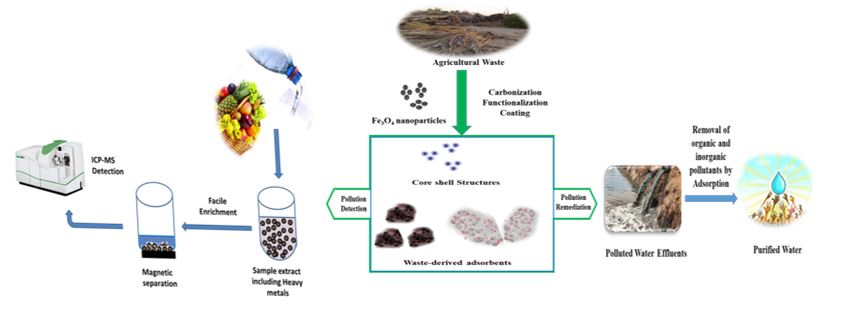Video Article Open Access
Mastering Core Shell and Renewable Composites-based Materials for Pollution Detection and Remediation towards Environmental Sustainability Practices
Mohamed A. Habila1,*, Zeid A. ALOthman1, Mohamed Sheikh1, Ahmed Mohamed El-Toni2, Saad A. Al-Tamrah1, Mustafa Soylak3, Joselito Puzon Labis2
1Chemistry Department, College of Science, King Saud University, Riyadh-11451, Kingdom of Saudi Arabia
2King Abdullah Institute for Nanotechnology, King Saud University, Riyadh 11451, Saudi Arabia
3Erciyes University, Faculty of Sciences, Department of Chemistry, 38039- Kayseri-Turkey
Vid. Proc. Adv. Mater., Volume 3, Article ID 2203268 (2022)
DOI: 10.5185/vpoam.2022.03268
Publication Date (Web): 23 Jul 2022
Copyright © IAAM
Graphical Abstract

Abstract
Sustainability based researches have become the most serious issue to keep environmental safety parallel to the industrial and economic developments. The rapid urbanization and industrial progress have led to over increase resources consumption as well as pollution production. In addition, the quantity of solid waste is continuously increasing and, if not managed properly, could cause severe harm to the urban environment. Common environmental pollutants include inorganic species such as heavy metals and organic species such as dyes and pesticides. International and local efforts have been paid for the remediation of the negative impacts of environmental pollution. Core shell-based materials as well as the nanocomposites recycled from solid waste have potential for application for solid phase extraction purposes to extract pollutants. In addition, these materials are efficient adsorbents to remove broad range of pollutants from contaminated water bodies for wastewater treatment applications.
Various adsorbents materials including Fe3O4 (OS/Fe3O4), OS/Fe3O4@SiO2 core-shell nanoparticles and functionalized Fe3O4 (np)@C were fabricated and applied for adsorption of some toxic metal ions and dyes from solutions. The adsorption process was characterized in terms of kinetic, equilibrium and thermodynamic investigations. The fabricated Fe3O4(np)@C adsorbents were tested for remediation of metal pollution by adsorption of Cu(II), Cd(II) and Pb(II) from wastewater. The modelling of the adsorption data has been applied and the calculated thermodynamic parameters including Gibbs free energy (ΔGo), enthalpy (ΔHo) and entropy (ΔSo) confirm the spontaneous process, with an adsorption capacity of 272.5, 262.5, and 284.5 mg/g for Cu(II), Cd(II) and Pb(II), respectively. In addition, removal of dyes is applied using the fabricated iron oxide (np)@carbon sheets prepared at 250 ˚C, 400 ˚C and 700 ˚C, in the weak acidic medium.The freundlich model was fount more suitable to describe the process of separation of dyes onto iron oxide (np)@carbon sheets, prepared at 250 ˚C and (B) 400 ˚C, suggesting heterogenous surfaces and multi-layer adsorption. Furthermore, an effective enrichment of Cr(III), Co(II), Cd(II), Zn(II) and Pb(II) was achieved by Magnetic Solid Phase Extraction (MAG-SPE) using magnetic nanoparticles prior to determination by Inductively Couples Plasma-Mass Spectroscopy (ICP-MS). For optimization of the extraction process, the analytical parameters, including pH, eluent type and sample volume, were investigated. The validation of the procedure was verified by the analysis of wheat gluten (8418) certified reference material. The limit of detection (LOD) of target elements was in the range of 0.001–0.11 µg L-1. The relative standard deviations (RSDs) were below 10%. The developed procedure was successfully applied for the enrichment of Cr(III), Co(II), Cd(II), Zn(II) and Pb(II) from samples with different matrices, including water and food samples.
Keywords
Solid waste management; magnetic materials; core shell structures; pollutants preconcentration; wastewater treatment.
Acknowledgement
Authors acknowledge the National Plan for Science, Technology, and Innovation (MAARIFAH), King Abdulaziz City for Science and Technology, Kingdom of Saudi Arabia for its grant with award number 13-ENV1186-02.
References
- Habila, M.A.; Alothman, Z.A.; El-Toni, A.M.; Al-Tamrah, S.A.; Soylak, M.; Labis, J.P.; Microchim Acta, 2017, 184(8), 2645.
- Habila, M.A.; Alothman, Z.A.; El-Toni, A.M.; Labis, J.P.; Li, X.; Zhang, F.; Soylak, M.; Microchim Acta 2016, 183(8), 2377.
- Habila, M.A.; Alothman, Z.A.; Al-Tamrah, S.A.; Ghafar, A.A.; Soylak, M.; J. Ind. Eng. Chem., 2015, 2, 336.
- Habila, M.A.; Alothman, Z.A.; Ali, R.; Al-Tamrah, S.A.; Ghafar, A.A.; Hassouna, M.S.E.; Clean - Soil, Air, Water, 2014, 42(12), 1824.
Biography
Mohamed A. Habila works as associate professor of chemistry, King Saud University. He is a board member of Saudi Chemical Society. Dr. Habila has got his PhD. in Chemistry, 2015 (thesis title, fabrication and characterization of the core-shell multi-functional nano-materials for analytical and environmental applications) from King Saud University, Saudi Arabia. In addition, He has obtained his MSc. in environmental studies, 2008 (thesis title, conversion of some wastes to activated charcoal for industrial applications) from Alexandria University, Egypt. He is interested in nanotechnology for development of clean methods for separation of environmental pollutants, improvement of solid phase extraction and dispersive micro-extraction, water and wastewater treatments, and synthesis and characterization of nano-porous multifunctional core-shell structures for various applications. Dr Habila is supervising more than 7 MSc and PhD. Students. Dr Habila has published more than 88 scientific articles, and has delivered more than 20 public lectures in chemistry in local and international conferences and scientific events. Dr. Habila has shared in managing of six funded projects (designing, running and reporting duties for each project) at King Saud University, in the fields of waste recycling and materials processing for environmental applications. According to google scholar citation index, Dr. Habila has h index of 25, total citation of 2335, as well as he received five awards:
- The King Saud University Scientific Excellence Prize 2013, for seventh branch in science and engineering “Student Research Excellence Prize”.
- The prize of the best oral presentation in the first scientific student meeting of Saudi Chemical Society 2013.
- Almarai Prize 2014 for the best creative research work (Co researcher).
- Academics World Excellent Paper Award for the category best presentation/best content at the Academics World International Conference held in Athens, Greece on 7th October 2015.
- Saudi Chemical Society for excellence in Society services, 2019.
Video Proceedings of Advanced Materials

Upcoming Congress



